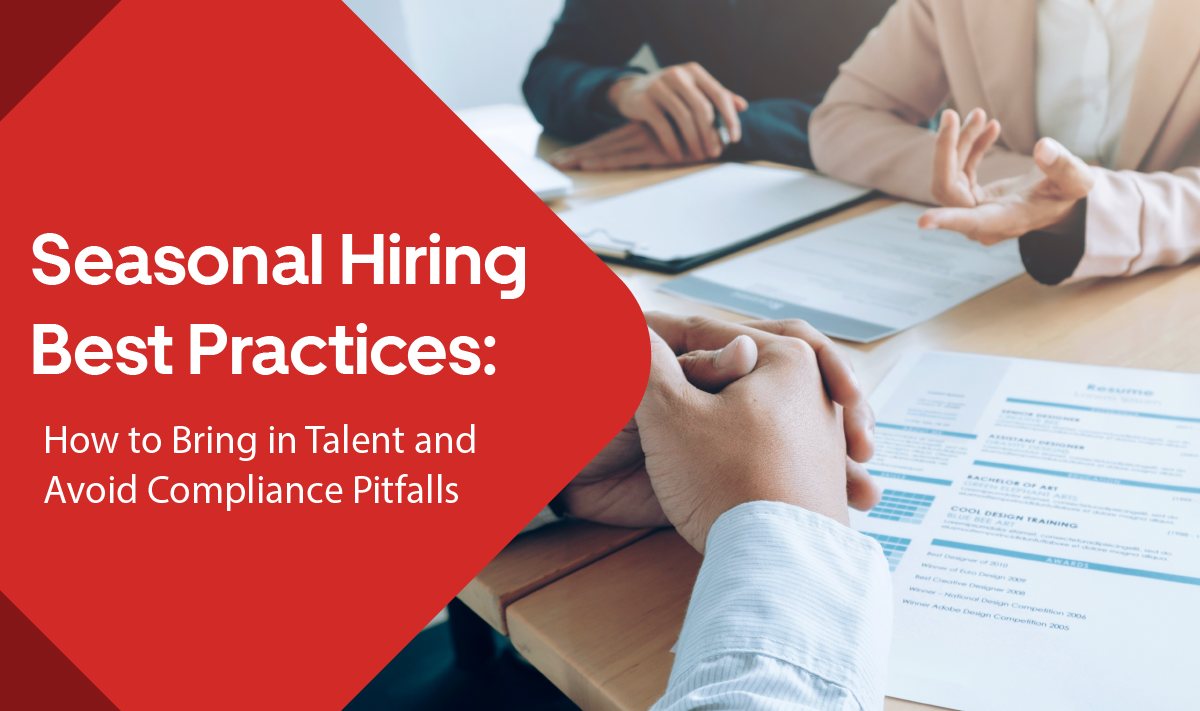
LSU100 List Recognizes Next Level Solutions
September 11, 2024
Holiday Office Parties: Tips for a Safe & Inclusive Celebration
November 7, 2024Almost every industry experiences natural ebbs and flows of activity throughout the year. Whether you’re a retail business, a tech company or a logistics firm, you might find yourself in need of extra hands. Hiring during these seasonal times is crucial to maintaining operational efficiency, managing the influx of work and ensuring customer satisfaction.
However, while it’s tempting to rush the hiring process during busy times, you should be mindful of compliance issues that can lead to costly mistakes. The goal is to hire quickly without cutting corners, and to build a workforce that can handle the immediate surge while avoiding legal pitfalls down the line. Let’s discuss some best practices for bringing in talent during seasonal busy times, while maintaining compliance and efficiency.
Understanding Your Seasonal Hiring Needs
Before you start posting job openings, it’s important to understand the seasonal patterns that affect your industry and your business specifically. Hiring is not just about reacting to immediate demand; it requires a strategic approach to ensure you have the right workforce in place when business is booming.
Identifying Busy Seasons
Each business has its own unique busy times, driven by industry cycles, market demands, and external factors like holidays, fiscal years, or product releases. Understanding when your busiest seasons occur is the first step in determining how much additional workforce support you’ll need.
Retail businesses, for instance, might see a surge in sales during the holiday season, while construction firms could be busier in spring and summer. Tech companies may experience increased workload around product launches or major updates, and service-based businesses like HVAC companies may have peak periods during extreme weather seasons.
By analyzing data from previous years, you can predict when these peaks will occur and plan accordingly, ensuring you start recruiting well ahead of time to onboard and train your new hires before the rush hits.
Planning for Workforce Fluctuations
Busy periods often require a temporary increase in workforce capacity, but businesses need to manage these fluctuations carefully. Hiring during seasonal times means finding the right balance between bringing in enough workers to handle the influx while not overstaffing to the point that payroll becomes a burden during slower months.
A mix of full-time and temporary workers can help businesses adapt to the changing workload. Having a flexible staffing strategy ensures you can scale up and down as needed, allowing you to stay agile while maintaining quality service during busy periods.
Best Practices for Hiring During Seasonal Busy Times
Once you’ve identified your busiest times and planned for your workforce needs, the next step is to put a hiring strategy in place. The goal is to bring in talent quickly without sacrificing quality or compliance. Here’s how you can do it effectively.
Streamline the Recruitment Process
Streamlining your recruitment process is critical to bringing in the right candidates fast. Start by crafting clear, concise job postings tailored to the roles you need to fill during your peak season.
- Clearly outline the specific skills and experience required for the role.
- Emphasize the importance of candidates thriving in a fast-paced environment.
- Communicate upfront that candidates will need to quickly jump in and contribute.
- Ensure clear communication about job expectations to avoid confusion or delays.
- Utilize recruitment software or applicant tracking systems (ATS) to manage high volumes of applicants efficiently.
Pre-Screening for Success
When hiring during peak times, it’s crucial to screen candidates effectively to ensure they can handle the demands of the job. While you may be in a hurry to fill positions, taking the time to conduct thorough pre-screening will save you headaches down the road.
- Focus on essential skills and qualifications specific to the role.
- Prioritize candidates with experience.
- Look for candidates with relevant certifications or training.
- Don’t skip background or reference checks, even under time constraints.
Offer Competitive Compensation and Flexibility
Hiring during busy times can be competitive, as many businesses are likely looking for talent at the same time. To stand out, you need to offer competitive compensation and benefits, even for temporary or seasonal roles.
- Offer flexible scheduling options, especially for part-time employees with other commitments.
- Provide a competitive hourly rate to attract quality candidates.
- Consider offering bonus incentives tied to performance during the busy period.
- Highlight opportunities for growth or full-time employment after the peak season.
- Emphasize that while the initial role may be temporary, there is potential for long-term advancement.
Avoiding Compliance Pitfalls During Seasonal Hiring
While speed is critical during seasonal hiring, it’s essential not to overlook compliance. Missteps in hiring practices can result in costly legal issues.It’s important to be vigilant about employment laws, classification and payroll regulations.
Understanding Employment Laws
Whether you’re hiring for temporary positions or full-time roles, all employees are entitled to fair wages and legal protections. The Fair Labor Standards Act (FLSA) sets standards for minimum wage, overtime pay and working hours, all of which apply to workers hired during seasonal busy periods.
Businesses must ensure that they’re paying employees correctly, tracking overtime hours and providing appropriate breaks. Misclassifying workers as independent contractors instead of employees can lead to significant legal and financial consequences. This is specially true when it comes to payroll taxes, workers’ compensation and benefits eligibility.
Correctly Classifying Workers
One of the biggest compliance challenges during busy times is correctly classifying workers. You might feel tempted to hire freelance or temporary contractors to avoid dealing with payroll taxes and benefits. However, you should understand the differences between a contractor and an employee.
The IRS and Department of Labor have strict guidelines for worker classification, focusing on the level of control you have over the worker’s schedule, tasks and work environment. Misclassification can result in fines, back pay and legal battles, so it’s critical to get this right from the beginning.
Handling Layoffs or Terminations After the Busy Period
Once the busy period is over, you may need to scale back your workforce. Handling layoffs or terminations legally and ethically is crucial to maintaining your company’s reputation and avoiding potential legal issues.
If you’re hiring employees for a short-term, busy season, make sure that they are aware of the temporary nature of their roles from the outset. Clearly outline the end date of their employment in contracts and offer support for the transition. Transparent communication will help you avoid misunderstandings and ensure a smooth off-boarding process.
Hiring during seasonal busy times can be a balancing act between finding talent quickly and ensuring compliance with employment laws. By understanding your business’s busy periods, streamlining the hiring process and maintaining compliance, you can successfully navigate these peaks without sacrificing quality or risking legal issues.
At Next Level Solutions, we help businesses manage the complexities of hiring during busy seasons, ensuring that you have the right talent in place while staying compliant with the law. Whether you’re preparing for the holiday season, a product launch or any other surge in demand, our team is here to guide you through every step of the hiring process. Contact us today to see how we can help!


